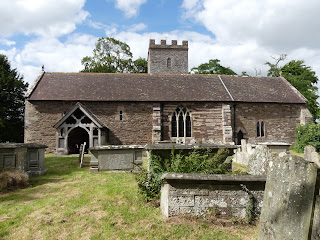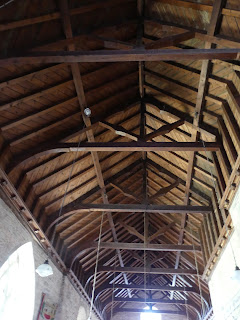As regular readers of this blog will know I love visiting churches but the church at Bredwardine was extra special because of its connection with Francis Kilvert.
Today Francis Kilvert is known mainly for his diaries which detail rural life. He was born on 3rd December 1840 at the Rectory near Chippenham, Wiltshire to the Reverend Robert Kilvert and his wife Thermuthis. He was educated by his uncle in Bath and then attended Wadham College Oxford before entering the church.
From 1863-64 he was curate to his father at Langley Burrell and in 1865 he took the position as curate at Clyro, Radnorshire. At Clyro he began writing a diary on 1st January 1870. I personally love his diaries with the details of the countryside and the walks he took, descriptions of his parishioners and his social life. He has a very conversational style.
In 1871 he fell in love with Frances (Daisy) Thomas, daughter of the vicar of Llanigon. He asked for her hand in her marriage but was refused by her father due to his position as a poor curate. (I seem to remember none of the daughter's married - sadly can't check as my books are in Herefordshire!) Shortly after in 1872 he resigned his post at Clyro and returned to his family's home.
From 1876/77 he was vicar of St Harmon, Radnorshire, and then in 1877 he accepted the position as rector of Bredwardine in Herefordshire. In August 1879 he married Elizabeth Ann Rowland, after meeting her on a trip to Paris, but died from peritonitis, shortly after returning from honeymoon, on 23rd September 1879. He was only 38.
Vicarage and Bredwardine Church from Brobury House gardens.
Bredwardine Bridge over the River Wye
The name Bredwardine means "the village on the bank" derived from bred (bank) and wardine (a homestead). It is located below Dorstone Hill.
I left B doing a crossword in the car and then realised later there was a bridleway by the church he could have followed down to the river!
St Andrew's Bredwardine
The church was constructed soon after the Norman Conquest and the nave still has Norman doorways and windows. The nave is 11th century and the chancel was added in 1300. It is unusual in that the tower is located on the north side and it may have replaced an original central tower when it was rebuilt in the 18th century.
There was a rather drastic restoration of the church in 1875/6 by Thomas Nicholson who added the large timber South porch.
Memorial bench to Francis Kilvert erected by the Kilvert Society.
Francis Kilvert's gravestone
The graves each side are those of a Miss Julia Newton and her sister Constance who lived in the "Cottage" who were both very fond of Kilvert. It meant that when Elizabeth, Kilvert's wife, died she had to be buried in the new churchyard nearby - I didn't have time to try and find her grave unfortunately.
Look at the lovely view :)
The vicarage next door where Francis wrote the last pages of his diary.
Norman doorway
And so into the church interior. There were 3 other people there and I chatted to them later by the car park - they were Kilvert enthusiasts too.
Looking up the nave towards the chancel (sorry - usual problem low light and high iso so photos again aren't brilliant).
12th century font with large plain round bowl built of breccia with a Jacobean cover.
The chancel
A lovely altar frontal
The oak reredos is by Frank Smallpiece dated 1904. Painted panels by Wyndham Hughes.
In the chancel are two recumbent effigies on tombs.
This worn 14th century knight in chain armour with apparently angels at his head is Walter of Bredwardine, grandfather of the figure in the other effigy. It is interesting to note that his legs are cut off at the knees so if this is lifesize he would have been very tall.
The second effigy is of Sir Roger Vaughan wearing plate armour and his head rests on a helmet. He was killed at the Battle of Agincourt.
East window - I haven't published close ups because in my humble opinion it is not the greatest stained glass!
Looking down the nave from the chancel
Herringbone masonry - a sign of late Saxon or Norman times.
As I left I suddenly remembered I hadn't seen the other Norman (blocked) doorway which I knew had carvings. A quick rush round the back of church no sign! I finally found it - goodness only knows how I had missed it!
An elaborately carved lintel with a rosette on each side in a circle and two "monsters". One looks like a monkey and the other a pig standing on hind legs. Although I did see one suggestion that the former may be a defaced sheela na gig. The lintel was probably the work of the Herefordshire School of Romanesque Carving although not carved by the master mason but perhaps a more local one?
As usual I missed features! - no surprise there! Even though I was carrying a handwritten crib sheet!
- C14th/C15th base of churchyard cross
- A better look at C19th chest tombs
- Fragment of Norman coffin lid with a cross on it
- Elizabeth Kilvert's grave
- A walk down the bridleway to see the earthworks and mound remains of Bredwardine Castle -a former keep of the Baskervilles and in the late C15th mansion of the Vaughan family.
Hopefully, we shall return and I can spend more time here.
Final Herefordshire post from this visit will be a Riverside Walk at Leominster.
I hope everyone is staying safe and well.
Photos taken by me with the Panasonic Lumix FZ330 bridge camera. (I don't particularly rate most of my photos but should anyone reading ever wish to use one I would appreciate an email first - thanks)
Reference:
"Exploring Kilvert Country" by Chris Barber
The Herefordshire School of Romanesque Carving by Malcolm Thurby Logaston Press
Pevsner The Buildings of England Herefordshire by Alan Brooks and Nikolaus Pevsner Yale University Press 2017
Wikipedia website page on Francis Kilvert



























































































